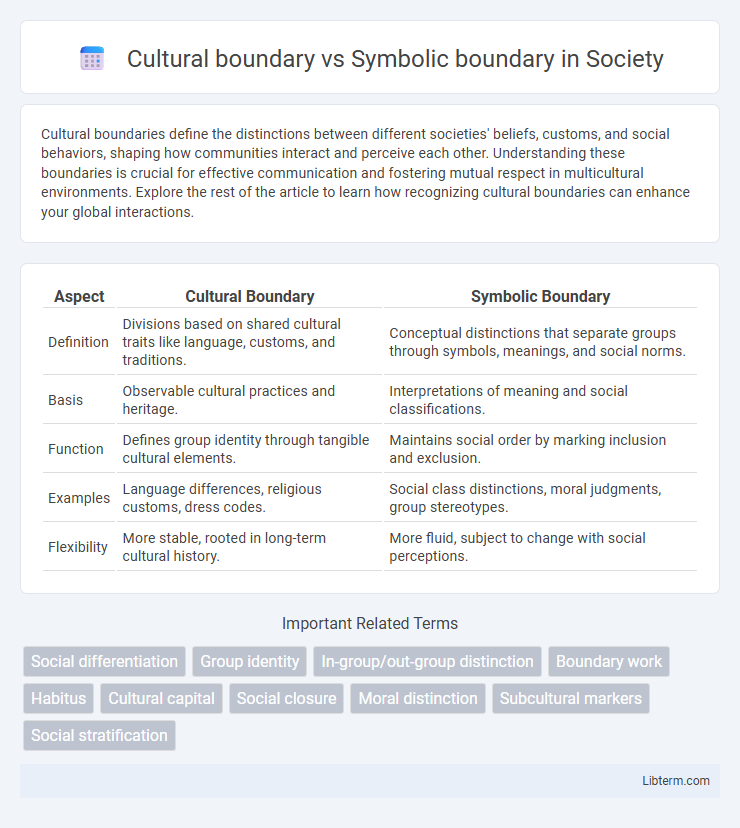Cultural boundaries define the distinctions between different societies' beliefs, customs, and social behaviors, shaping how communities interact and perceive each other. Understanding these boundaries is crucial for effective communication and fostering mutual respect in multicultural environments. Explore the rest of the article to learn how recognizing cultural boundaries can enhance your global interactions.
Table of Comparison
| Aspect | Cultural Boundary | Symbolic Boundary |
|---|---|---|
| Definition | Divisions based on shared cultural traits like language, customs, and traditions. | Conceptual distinctions that separate groups through symbols, meanings, and social norms. |
| Basis | Observable cultural practices and heritage. | Interpretations of meaning and social classifications. |
| Function | Defines group identity through tangible cultural elements. | Maintains social order by marking inclusion and exclusion. |
| Examples | Language differences, religious customs, dress codes. | Social class distinctions, moral judgments, group stereotypes. |
| Flexibility | More stable, rooted in long-term cultural history. | More fluid, subject to change with social perceptions. |
Defining Cultural Boundaries
Cultural boundaries are defined by shared language, traditions, and social practices that unite members of a group and distinguish them from others. These boundaries manifest in rituals, customs, and collective values that create a sense of belonging and identity across communities. Symbolic boundaries, in contrast, are conceptual distinctions made by individuals or groups to categorize people, behaviors, and social differences, often based on perceptions of morality, taste, or status.
Understanding Symbolic Boundaries
Symbolic boundaries are the conceptual distinctions made by social groups to categorize objects, people, practices, and even time and space, shaping group identity and social inclusion or exclusion. Understanding symbolic boundaries involves analyzing how these mental and cultural classifications influence behavior, power dynamics, and social cohesion within and between communities. Unlike cultural boundaries, which often have tangible or geographic markers, symbolic boundaries operate through shared meanings and symbols that define social realities and collective belonging.
Historical Development of Boundary Concepts
Cultural boundaries, historically rooted in distinct shared practices, languages, and traditions, have evolved through social interactions and territorial claims, reflecting tangible divisions among groups. Symbolic boundaries emerged from sociological theories in the late 20th century, emphasizing perceived distinctions based on values, norms, and identity markers that influence social inclusion or exclusion without physical demarcations. The development of boundary concepts shifted from concrete geographic separations to abstract sociocultural constructs, highlighting the fluid and dynamic nature of group identities over time.
Key Differences between Cultural and Symbolic Boundaries
Cultural boundaries refer to the divisions based on shared language, traditions, customs, and collective identity within groups, influencing social behavior and group cohesion. Symbolic boundaries, on the other hand, are conceptual distinctions people create to categorize others based on differences in taste, morality, or lifestyle, often reinforcing social inequalities and group distinctions. Key differences lie in cultural boundaries being rooted in tangible practices and heritage, while symbolic boundaries operate through perceptions and social judgments that shape group inclusion or exclusion.
Social Functions of Boundaries
Cultural boundaries define group membership based on shared languages, customs, and traditions, fostering a sense of identity and cohesion within social groups. Symbolic boundaries categorize people through perceived differences in values, morals, and lifestyles, helping individuals navigate social hierarchies and maintain social order. Both boundaries play crucial social functions by structuring interactions, enabling group solidarity, and differentiating insiders from outsiders in complex societies.
Boundaries and Identity Formation
Cultural boundaries define group identity through shared language, customs, and traditions, establishing clear distinctions between communities. Symbolic boundaries operate more fluidly by marking social distinctions based on perceived values and lifestyles, influencing individuals' self-identification and group inclusion. Both types of boundaries play critical roles in identity formation by shaping social cohesion and differentiating in-group versus out-group members.
Impact on Social Inclusion and Exclusion
Cultural boundaries define tangible differences in language, customs, and practices that shape group identities and influence social inclusion by fostering a sense of belonging or exclusion based on shared heritage. Symbolic boundaries operate through perceptions, values, and norms that distinguish insiders from outsiders, often reinforcing social hierarchies and exclusion through cultural judgments and stereotypes. Both types of boundaries significantly impact social cohesion by either enabling integration within communities or perpetuating social divides and exclusionary practices.
Examples in Contemporary Society
Cultural boundaries manifest in distinct practices, languages, and traditions that separate ethnic groups, such as the division between Hispanic and Anglo communities in the United States marked by language and cuisine. Symbolic boundaries, by contrast, are more fluid and involve social distinctions based on lifestyle, values, or tastes, exemplified by the divide between urban hipsters and rural traditionalists in fashion and music preferences. Contemporary society shows these boundaries shaping social inclusion and exclusion, influencing identity politics and community cohesion in multicultural cities like New York and London.
Challenges in Distinguishing Boundaries
Cultural boundaries and symbolic boundaries often overlap, making it challenging to distinguish between the two due to their intangible and dynamic nature. Cultural boundaries refer to the shared practices, beliefs, and norms that define social groups, while symbolic boundaries represent the conceptual distinctions people draw to categorize others and reinforce social inequalities. The fluidity of cultural expressions and the subjective interpretations of symbols increase the complexity of accurately identifying where one boundary ends and the other begins.
Implications for Social Change
Cultural boundaries define distinct group identities based on shared customs, language, and traditions, shaping social cohesion and group solidarity. Symbolic boundaries, as conceptual distinctions made by social actors, influence perceptions of inclusion and exclusion, often reinforcing social hierarchies and power dynamics. Understanding the interplay between cultural and symbolic boundaries is crucial for social change, as challenging symbolic boundaries can disrupt entrenched inequalities and foster more inclusive societal transformations.
Cultural boundary Infographic

 libterm.com
libterm.com